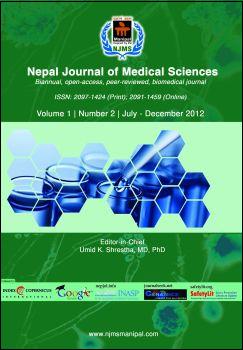Prevalence and treatment needs of dental caries in school-going children attending dental outpatient department of a tertiary care centre in western region of Nepal
DOI:
https://doi.org/10.3126/njms.v1i2.6611Keywords:
Dental caries, prevalence, treatment needsAbstract
Background: Dental caries is one of the commonest oral problems affecting children globally involving the people of all region and society. It can be seen in all age groups of children involving both deciduous and permanent teeth. Treatment of dental caries involves restorative or pulp therapy which is not only expensive but also painful and demanding for the child. Considering these factors prevention of caries seems to be the most acceptable and desirable option.
Methods: A descriptive study was conducted on department of Dental Surgery, Manipal teaching Hospital, Fulbari, Pokhara. Total of 3174 school going children attending Dentaloutpatient department, from 1st January 2008 to 31st December 2009, from the age group of 5-14 years were included in the study.Assessment was carried out usingWorld Health Organization (1997) criteria.Data was compiled and subjected to analysis using SPSS version 12.0.
Results: Prevalence of Dental caries in study population was found to be 47.1%. Caries prevalence in the age group 5-7, 8-10 and 11-14 years were 20.7%, 48.2% and 52.46% respectively. Mean Decayed missing and filled teeth (DMFT) in the age group 5-7, 8-10 and 11-14 years were 1.96, 2.43 and 1.84 respectively. The treatment requirement in age groups of 5-7years, 8-10 years and 11-14 years children were 87.2%, 85.3% and 71.4% respectively.Most cases required single surface filling.
Conclusion: The prevalence of dental caries was highest in age group of 11-14 years; mean DMFT was highest in age group of 8-10 years and the treatment need was highest in age group of 5-7 years.
DOI: http://dx.doi.org/10.3126/njms.v1i2.6611
Nepal Journal of Medical Sciences. 2012;1(2): 115-8
Downloads
Downloads
Published
How to Cite
Issue
Section
License
Copyright © by Nepal Journal of Medical Sciences. The ideas and opinions expressed by authors of articles summarized, quoted, or published in full text in this Journal represents only opinions of authors and do not necessarily reflect the official policy of Nepal Journal of Medical Sciences or the institute with which the author(s) is (are) affiliated, unless so specified.




